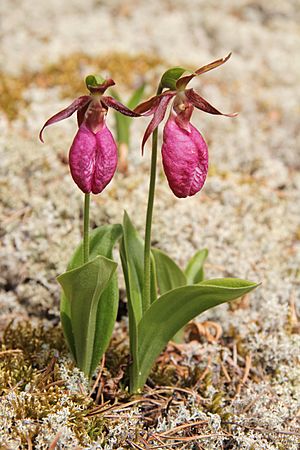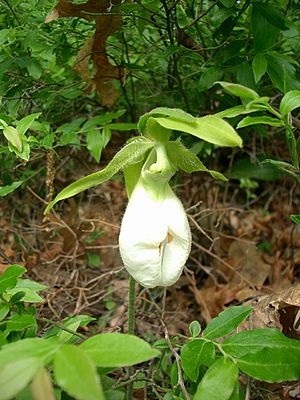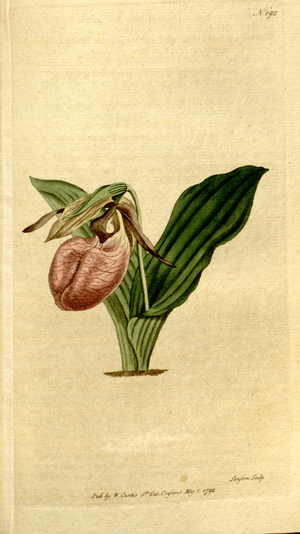Cypripedium acaule facts for kids
Quick facts for kids Cypripedium acaule |
|
|---|---|
 |
|
| Conservation status | |
| Scientific classification | |
| Genus: |
Cypripedium
|
| Species: |
acaule
|
The pink lady's slipper (scientific name: Cypripedium acaule) is a beautiful flowering plant that belongs to the Orchid family. People also call it the moccasin flower because its shape looks a bit like a moccasin shoe. Its scientific name, acaule, means "without a stem," which is interesting because this plant has a very short stem that grows underground. This is why it's also known as the stemless lady's-slipper.
This special flower is the official provincial flower of Prince Edward Island, Canada. It is also the state wildflower of New Hampshire in the United States.
Contents
What Does the Pink Lady's Slipper Look Like?
Unlike most other lady's slipper orchids, the pink lady's slipper has a unique opening. Its pouch, which is a part of the flower called the labellum, opens with a slit down the front instead of a round hole.
The plant itself usually has two large, folded leaves that grow close to the ground. From between these leaves, a tall, fuzzy stem grows up. This stem holds a single, beautiful pink flower. The other parts of the flower, like the sepals and petals, are often yellowish-brown to maroon. The large pouch is usually a shade of pink, but it can sometimes be a deep magenta color.

Where Does the Pink Lady's Slipper Grow?
You can find the pink lady's slipper in the eastern part of the United States. It is especially common in the Great Lakes Region and the Northeast, including states like New Hampshire and Maine. It also grows south along the Appalachian Mountains all the way to Alabama.
In Canada, this plant is widespread. It grows in every province except British Columbia. It can also be found in the Northwest Territories and on the islands of Saint Pierre and Miquelon.
This amazing plant can live in many different places. You might see it in coastal areas, sandy pine forests, or even on mountaintops!
What Kind of Home Does This Plant Like?
The pink lady's slipper needs soil that is very acidic. Think of it like a plant that loves sour candy! It can handle different amounts of shade and moisture, but it prefers at least some shade and slopes where water drains away easily.
You will often find large groups of these flowers in pine forests. They can also grow in forests with deciduous trees (trees that lose their leaves in autumn). For a long time, people thought this orchid needed a special fungus to grow. Now we know that this fungus is mainly needed for the orchid seeds to sprout. Once the plant starts growing its true leaves, it doesn't need the fungus anymore.
Sadly, the pink lady's slipper is considered endangered in Illinois and Tennessee. It is vulnerable in New York and is listed as "unusual" in Georgia.
Growing Pink Lady's Slippers at Home
It can be tricky to grow pink lady's slippers outside of their natural home. However, labs that help seeds sprout have made it a bit easier to buy these plants. They are still not as common as other types of Cypripedium orchids because they need special care.
The Importance of Acidic Soil
This plant needs soil with a pH level below 5, often around 4 to 4.5. (pH measures how acidic or basic something is; lower numbers mean more acidic). In very acidic soil, certain fungi that might harm the plant are kept away, allowing the pink lady's slipper to grow well. Some scientists even think the plant might get some nutrients by "borrowing" from fungi that try to grow on its roots! If the soil pH is above 5, other tiny living things in the soil can become too much for the plant, and it might rot.
Tips for Growing in Containers
If you want to grow a pink lady's slipper, it's best to keep it in a container. The soil mix must be naturally acidic. You also need to make sure that nothing you add to the soil has calcium, as calcium can make the soil less acidic.
Good choices for growing medium include high-quality peat moss or pine duff (decaying pine needles). You can add perlite, which doesn't change the pH, to help the soil drain better.
It's also important to use the right kind of water. Tap water often has calcium, so it's not good for this plant. Instead, use rainwater or distilled water. You can even add a tiny bit of vinegar (about 2 ounces per gallon) to make sure the water stays acidic.
Place your potted plant where it gets bright, dappled shade or morning sun. In winter, you can bury the pots in the ground or put them in a cold frame to protect them from the cold. If you follow these steps, your pink lady's slipper can live for a long time. Just remember, it needs more attention than other orchids that can grow in a wider range of soil conditions.
See also
 In Spanish: Sandalias de la Virgen para niños
In Spanish: Sandalias de la Virgen para niños




